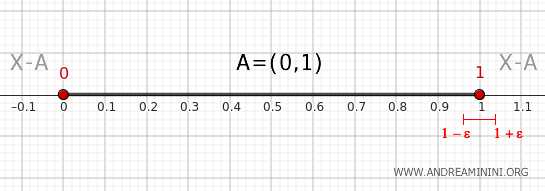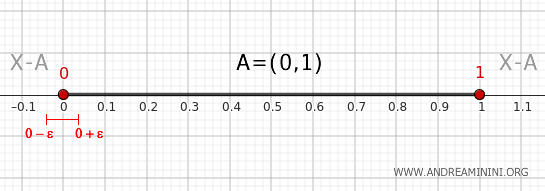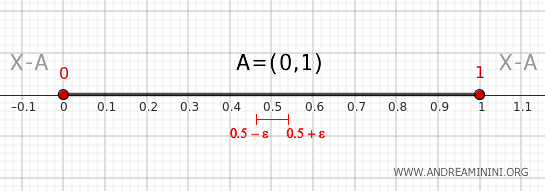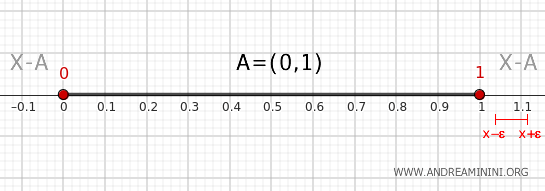Boundary Theorem of a Set
A point \( x \) belongs to the boundary of a set \( A \) if every neighborhood of \( x \) intersects both the set \( A \) and the complement of \( A \) (i.e., \( X - A \)).
In other words, if you can't find a neighborhood of \( x \) that lies entirely inside \( A \) or entirely outside \( A \), then \( x \) is on the boundary of \( A \).
A Practical Example
Let's look at a practical example to better understand this concept.
Consider the set \( A = (0, 1) \) on the real line \( \mathbb{R} \).
The points 0 and 1 are on the boundary of \( A \) because any neighborhood of 0 or 1 will always have a part inside \( (0, 1) \) and a part outside \( (0, 1) \).
- Point 1
Any neighborhood \( (1-\epsilon, 1+\epsilon) \) with ε infinitesimally small has a part \( (1-\epsilon,1) \) within \( (0,1) \) and a part \( (1,1+\epsilon) \) outside \( (0,1) \). Thus, the point 1 is a boundary point of the set \( A \).

- Point 0
Any neighborhood \( (0-\epsilon, 0+\epsilon) \) with ε infinitesimally small has a part \( (0,0+\epsilon) \) within \( (0,1) \) and a part \( (0-\epsilon,0) \) outside \( (0,1) \). Thus, the point 0 is also a boundary point of the set \( A \).

- Point within the interval (0,1)
Any point \( x \) within the set has a neighborhood \( (x-\epsilon, x+\epsilon) \) with ε infinitesimally small that belongs to \( A = (0,1) \) but not to \( X-A \). Therefore, the interior points of the interval \( (0,1) \) are not boundary points.

- Point outside the interval (0,1)
Any point outside the interval \( (0,1) \), except for 0 and 1, has a neighborhood \( (x-\epsilon, x+\epsilon) \) with ε infinitesimally small that lies within \( X-A \) but not within \( A = (0,1) \). Hence, the points outside \( [0,1] \) are not boundary points of \( A \).

Therefore, the boundary points of the set \( A \) are the points 0 and 1.
$$ \partial A = \{0,1 \} $$
In summary, a point \( x \) is on the boundary of \( A \) if you can never find a neighborhood that lies entirely inside \( A \) or entirely outside \( A \). Is that clear now?
The Proof
To prove the theorem, I will consider two hypotheses:
1] The point \( x \) is a boundary point of \( A \)
Consider a point \( x \) on the boundary of the set \( A \)
$$ x \in \partial A $$
This implies that \( x \in \text{Cl}(A) \) and \( x \notin \text{Int}(A) \).
Since \( x \in \text{Cl}(A) \), every neighborhood of \( x \) intersects \( A \).
Moreover, since \( x \notin \text{Int}(A) \), every neighborhood of \( x \) is not a subset of \( A \) and thus must intersect \( X - A \).
Therefore, every neighborhood of \( x \) intersects both \( A \) and \( X - A \).
2] The point \( x \) intersects both \( A \) and \( X-A \)
Now, suppose that every neighborhood of point \( x \) intersects both \( A \) and \( X - A \).
It follows that the point belongs to both sets \( x \in \text{Cl}(A) \) and \( x \in \text{Cl}(X - A) \).
Given that \( \text{Cl}(X - A) = X - \text{Int}(A) \), I deduce that \( x \notin \text{Int}(A) \).
Therefore, \( x \in \text{Cl}(A) \) and \( x \notin \text{Int}(A) \), meaning \( x \in \text{Cl}(A) - \text{Int}(A) = \partial A \).
This proves that the point \( x \) is a boundary point of \( A \).
